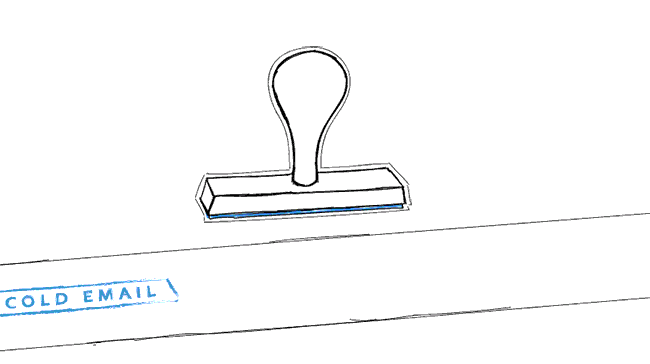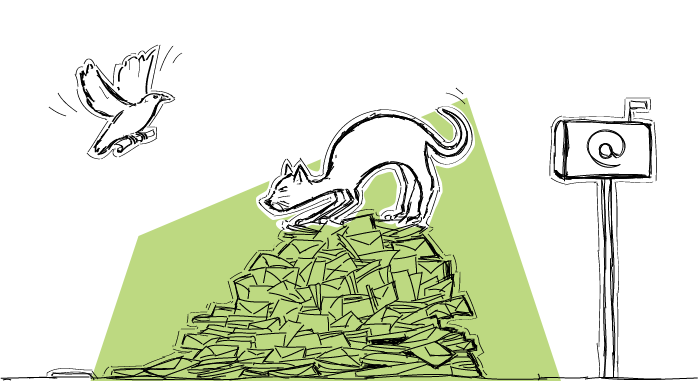This week we have a guest on the Woodpecker blog. Nina Cvijovic, who is a researcher and writer, analyzed 10 reasons why your outbound email campaigns may not be reaching the response rate you expect them to, or are not generating any responses at all. Either way, there’s always a field for improvement in cold emailing. So go through the 10 checkpoints below, and read some advice on how your response rates can be improved.
Take it away, Nina.
***
I really love emails.
Email is basic, neutral and an everlasting service. Don’t be surprised but email is also a more personal medium than social media, if we are talking about business.
Today new tools and social media platforms make a big difference in how we connect and communicate. A lot of work-related messaging and friendly chats have been relocated to online platforms. Marketing has also changed and is still finding innovative ways to get to us.
Yet, good old email still rocks!
According to Martin Zhel, these are the advantages of email marketing in comparison to social media:
- Higher click rates – your email is more visible than a social media post.
- Higher conversion rates – you have the ability to personalize your messages and deliver targeted content based on different variables in a behavior of your subscribers.
- More direct conversions – if you are a B2B or even B2C company, email marketing will perform better and give you more tangible results.
- Better ROI – email marketing is less expensive and easier to use. According to National client email report, email has an average ROI of 3800%.
In the end, as he says, email marketing and social media are simply different. “Email is in general better at driving traffic and direct conversions, and social media – with engaging with your audience.”
Social media is a great marketing platform, but if your goal is to reach leads, convert them into opportunities or drive sales, email marketing should be your choice, and the first step towards growing your business – a great email outreach.
If your email outreach is not performing as it should, remember: it’s not about email, it’s about how you’re using it.
Don’t give up yet – check out these common mistakes people make, and the reasons their email outreach has little success.
I will also show you how you can turn these bad practices into good ones and how to start writing great outreach emails.
So why you get no responses to your cold emails?
1. You’re talking about yourself
Remember, outreach emails are less about you and more about the recipient.
Try to think of it as a real life conversation. If you start talking on and on about yourself, the other person won’t see the point of that conversation and will probably find an excuse to walk away.
The same logic can be applied to emails. If you start your email by talking about yourself, your recipients won’t understand why you are even reaching out to them.
What you can do about it:
Change your perspective. Start by answering these questions:
- Why am I contacting this person?
- What do I have to offer the person I’m sending the email to?
- How can that person’s business benefit from my service?
Skip the long introduction about yourself and go straight to what you can provide to them. Simply explain why they should spend time on reading your email.
Also, use more you and less I. Communication is a mutual exchange, so try to make it balanced. You are the one who is reaching out, so put your focus on them instead of yourself.
2. Your email is too long and you’re asking too much
Now, we all know that everyone in this world is busy, I mean super busy, especially people who work and are great at what they do.
Somehow, you are still writing giant email essays that no one wants to read.
Or they start to read them, get lost in all those sentences, and at one point just turn it off. Another case would be that your email is long but interesting, so they leave it for later and forget about it entirely.
Most people’s jobs are not just reading and responding to emails, they have a lot more to do. And if you are asking for way too much, people will simply ignore that.
If a stranger asks you to read and review his book? Would you do that? Or if someone asks you to check out what their company offers and see if there’s anything relevant for you? Isn’t that something they should tell you?
What you can do about it:
Be an empathic person. Not only in your email communication, but in every sphere of life.
Consider how much time is valuable for every individual. If you are reaching out to them make it short. The true virtue is to be concise.
First of all before you research out to your recipients, find out what they might be interested in, get to know how you can help them, and try to do as much as possible in order to make their response an easy task.
For example:
If you have a few things to offer make an abc list and ask them to simply chose one letter.
If you are looking to guest post on someone’s blog, don’t ask them to give you ideas on what you can write about. Do your research and come up with a few relevant ideas they might be interested in, and again just ask them to choose.
3. You’re not backing up your claims
You’re using generic sentences like these:
I love your work.
I’m a big fan of your blog.
Your company means a lot to us.
And that’s it.
Maybe you mean it. Ok. But they don’t know you do until you prove it.
Or you’re saying something like this:
I’m best at what I do.
I have a lot of experience.
I’ve helped a lot of people achieve great results.
Everyone wants some honesty, so don’t forget to back up what you’re saying.
What you can do about it:
Simply prove it.
If you say I love your work, make sure you explain why, what is great about it and how it can be related to the offer you are sending.
If you are a fan of someone’s blog, you will be able to state what you like about it, what articles caught your attention and why that is relevant for the rest of the conversation.
On the other hand, if you are a true fan of someone’s blog you will be their subscriber and you will probably leave comments on their articles. You will also engage in their social media posts. In this way they will notice you before you reach out to them for the first time.
If you are talking about your accomplishments, don’t say I’m best at what I do, they won’t buy it, nor will they spend time on further investigation. Explain what makes you best at what you do. Mention in one sentence with whom you worked before and show them you have a relevant authority that can guarantee for your skills or your product.
4. Your email is not personalized
Here is what you might be doing:
You’re using the same template to reach a large amount of people.
You’re starting emails with Hi, and you don’t even include their name.
You know that weird feeling you get when you read a completely generic email?
My subconscious mind is pushing me to send that email to trash and move on with my work. I can’t relate to that person nor am I trusting him or her, and therefore I will not engage in further communication.
They didn’t spend time on me, so why should I spend time on them?
What you can do about it:
It’s crucial to achieve quality over quantity.
If you are in for the quantity you can join others in the spam folder.
If you do your research, write high-quality emails that are personalized and send them to only 10 people, you will see how you can achieve more with this approach than with sending one template to 100 people.
You should use templates, they will help you a lot and serve you as a guide for crafting different emails. But don’t forget to personalize those templates.
Here are some examples:
- Send emails to personalized email addresses.
- Get to know their names, that’s the first and the most basic step. Mention it once or even twice.
- Add their company name in the subject line and in the email body.
- Find out about their recent achievements and congratulate them.
- Find what you have in common and mention it.
- Offer what is really relevant to your recipient.
Get to know their weak spots and mention how you can help them.
5. They don’t know you
You are doing cold outreach to complete strangers. And that is what cold emails are about.
The question is – Can you add some spice to the outreach process?
According to 2017 Email Marketing Benchmark Report the average email open rates are 24,79% and the minimum open rates 16,64%.
If you are not satisfied with your email open rates or you want to do better, you should think about making stronger connections with your potential clients.
Get them to know you better before you reach out to them.
What you can do about it:
Instead of pitching your leads with an offer, start with introducing yourself.
You don’t have to ask for anything in this email. The reason why you’re reaching out to them is to let them know you exist. You can also point out what you have in common, what you do and why you are interested to connect with them.
This is a great way to start a relationship with your recipients. Later, when you send the first outreach email you won’t be a complete stranger.
Follow your leads on social media. Engage in their content, leave comments. They will surely remember you.
If you spot some mistakes on their website, send them a friendly email about it. And if you can help them improve something, offer it without asking something in return.
To boost it even more, try to connect with your leads in the real world. Meet them at conferences, chat with them. This approach can help you a lot.
We all need a bit of human touch. And even hearing someone’s voice or seeing them will make a solid base for the future relationships.
6. Your email contains typos
This one is very simple but yet a strong email cracker.
A lot of people are not checking their emails carefully before they send them.
I understand that you’re in a hurry, but, remember, haste makes waste.
Don’t let some mistakes throw all the time you spent crafting that email.
People are naturally rejected by emails that contain typos. They will find you and your email not professional enough and they won’t bother reading it at all.
What you can do about it:
Always check your emails twice before you send them.
Don’t rely only on check speller. It can help you out but it can also trick you. For example, some check spellers won’t mark incorrect use of you’re or your in a sentence.
Even though check speller is improving and using artificial intelligence to make recommendations, your eyes and your email review should be the most important.
7. You don’t follow up
You send the first outreach email and no one answers, therefore you mark that lead as a lost opportunity.
A lot of people lose track of the things they have to do and they make their own reminders not to forget. So why shouldn’t you remind them about your email?
Being persistent and believing in what you do is the key to success. Don’t be shy and don’t give up yet. Sometimes people will be happy you followed up.
What you can do about it:
As Christoph Engelhardt says in his book SaaS Email Marketing Handbook, you should follow up until you get a yes or no.
Craft different follow-ups and schedule them. You can send your first follow up after three days and the second one after a week. And for the third and fourth follow up you should wait longer, around two, three weeks or a month.
And the main question is not – Should I send follow-ups? It is – Am I sending follow-ups to the right people?
In other words, be persistent but with a so-called qualified lead that have interest in your product or service and that have a potential to become your opportunities.
8. You bought a pre-made email list
You think you did yourself a favor by buying these email lists.
It saved you a lot of time, and I agree with that. But at what cost?
Now you are reaching out to people:
- who are not relevant to you
- who are not interested in your offer at all
- who don’t want to receive your emails
- whose email addresses are not in use anymore
- whose personal details are out of date
And not only that your outreach won’t have a good outcome, you are also putting yourself at the risk of compromising your sender reputation.
What you can do about it:
Find your own email contacts. Remember, no one knows your business better than you, and you should be in control of choosing your leads.
This is the first and the most important step before you start crafting and sending your emails. Make it right and the rest will fit perfectly into a puzzle.
There are a lot of ways to find prospects’ emails.
If you are a small business or you are reaching out to a small number of people, good old, effective web scraping will do the job for you.
On the other hand, if you want to reach out to more people and grow your business on a larger scale you should consider different tools that can help you finish this process as quickly as possible.
One of the tools I use for gathering relevant email addresses and verifying them is our own Etools.io. There are also other ones that you can experiment with, like FindThatLead.
You should look for tools that will help you out in the whole lead generation process. For example, tools that search domains by keywords, extract email addresses and verify them, and also show your leads’ personal details that you’ll need later for crafting and personalizing your emails.
9. Your offer is not relevant to them
Now, you might be doing everything right. Your subject lines are excellent, your emails get to the point, they are short and easy to read with a clear CTAs. But somehow the results you’re getting are not satisfying.
What might be causing this problem is that you are putting your efforts on the wrong audience and your offer means nothing to them.
What you can do about it:
When you discover that you’ve been targeting the wrong people or businesses in your outreach, you should step back and reexamine what you have to offer and to whom you should offer it to.
Ask yourself – What is it that you’re offering that could really change the game for a certain business?
You need to find out which company roles, company sizes or even industries have the biggest interest in your offer.
First of all, you can change your offer and make it more relevant to the target market you are trying to reach.
And the other thing you can do is to change your target market. This will give you even better results.
In your efforts to change your target market, be prepared to do a lot of A/B testing, and make sure to keep track of the right metrics.
And that leads us to the next reason:
10. You don’t test your emails
You send outreach emails but you never test them.
You might be repeating the same mistake over and over again and you don’t know which one. Knowing what is not working good will help you become better and evolve.
Every audience is different. You can find great information online about how to craft your email, what to use as a subject line, how to point out your CTA or when to send those emails.
But without testing them you won’t know for sure what your audience prefers.
What you can do about it:
The most standard and basic email tests are A/B tests. You should select just one variable you want to test in order to get the most accurate results.
You can choose to test:
- Subject line – you can test different subject lines and see which one gets more open rates.
- Email body – you can test the way you format your text or the length of your message.
- Call-to-action – make different CTAs to see which performs better.
- Personalization – see if including recipient’s name twice can make a difference.
- Images – test emails with or without images.
Also, find out what metrics are causing you problems.
Is it open rates? Make sure you find the best subject line that will trigger your leads to open your email in the first place.
Is it conversion rates? Then test your CTAs or your email body.
Conclusion
Email outreach is one of the easiest and most effective ways to grow your business. It’s perfect for converting leads, driving sales and making business relationships.
If you are not getting the desired results then it’s time for a big email spring cleaning. Have this list in mind and start checking your outreach process from start to finish.
I would love to hear about your email outreach. Has this list made you reconsider your email outreach? Have you overcome these problems in the past and how?
FAQ on why you’re getting no responses to your cold emails
Check out the answers.
READ ALSO

Cold Email Clichés, or What Your Prospects Have Seen Too Many Times to Care
If you've been into cold emails for some time, or if you get hundreds of cold emails into your inbox, you are probably able to quote some cliché phrases and structures showing up over and over again for years. I described just a few of them below. Check if you know them. Check if you use them. Check how to replace them, which may probably boost your reply rates.

5-Minute Campaign Audit for a Cold Email Newbie
Are you just one click away from sending your first cold email campaign? Then this post is for you. Hold your horses for a moment, and spare a few minutes to do a quick campaign audit before you click the ‘send’ button. Here’s what you should check to make sure your campaign is all set and ready to go.

Which Cloud Tools Help Us Grow Woodpecker – PickSaaS.com Interview
Recently, I had a pleasure to talk to Matt from picksaas.com, an online company focused on finding useful cloud apps for businesses. He asked me about growing Woodpecker to +1000 customers, and about what cloud applications help us grow. Read the interview below.

